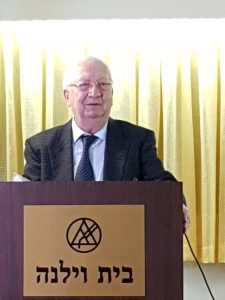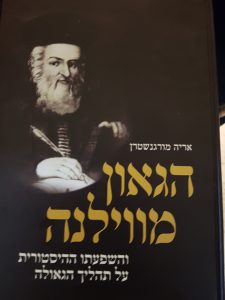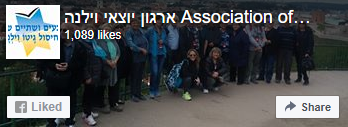The Vilna Gaon and his Historical Influence on Hastening the Redemption
 On January 8, 2019, Dr. Arie Morgenstern's book was launched at Bet Vilna:
On January 8, 2019, Dr. Arie Morgenstern's book was launched at Bet Vilna:
“The Vilna Gaon and his Historical Influence on Hastening the Redemption” (Dr. Morgenstern’s English Version is entitled The Vilna Gaon and His Messianic Vision).
From the back cover of the book:
"According to new historical sources uncovered by the historian Dr. Arie Morgenstern in the Netherlands, and in the former Soviet Union, the Vilna Gaon tried to immigrate to Eretz Israel in the summer of 1778 to compose a new" Shulchan Aruch," an agreed-upon final halakhic code that would bring an end to halakhic disputes within the Jewish world and bring the redemption process closer.
When Heaven did not agree with him ("I have no permission from Heaven"), the Vilna Gaon established a Beit Midrash (House of Learning) in 1779 which he headed for 18 years until his death. During these 18 years, he established a number of principles (“Elaborations”) to continue the redemption process, especially regarding the Jerusalem Talmud:
Repeal of the "Three Weeks" prohibiting mass immigration to Eretz Israel and encouraging the coming of the Messiah; end time does not depend on repentance but on divine grace; redemption will not be in a miraculous but in a natural way, "little by little", according to the Jerusalem Talmudic method and as it was at the time of Koresh; the redemption process will begin not by divine inspiration but human intervention (Aramaic: atarutha delta): Redemption will begin by aliyah to, and the settling of, Eretz Israel and the rebuilding of Jerusalem first.
The 511 disciples of the Vilna Gaon and their families, who immigrated to Eretz Israel in the early nineteenth century, together with the thousands who followed, changed the face of Jewish history: They renewed the Jewish settlement in Jerusalem and broke outside the Old City walls. They expanded the city’s settlement and made its Jewish inhabitants the majority as early as 1860. Thus, Ha-Gaon Rabbi Eliyahu established a solid foundation for the further development of the redemption process."
The Vilna Gaon and the Redemption / from the Blog of Yossi Regev
The Vilna Gaon R. Eliyahu was a great Talmudist, an influential authority in rabbinic study, as well as a pioneer in everything related to the settling of the Land and Redemption. The Gemara tells the story of the Three Weeks that God had Israel promised to Him - the principle being that they would not immigrate to Israel. This was the Babylonian rabbis’ excuse for not keeping the explicit commandment of going to live in the Land of Israel; the excuse used by Jews living in the Diaspora for not immigrating to Israel, even during periods when there was no serious impediment to immigration, when the government was not hostile to Jews.
The Gaon referred to the Three Weeks and ruled that there was no impediment to immigrating to the Land of Israel. The ban was on building the Holy Temple before the coming of the Messiah (a note to the attention of the members of the "Temple Institute"). Moreover, the Vilna Gaon commanded immigration to Israel. He himself tried to immigrate to Israel and encouraged his disciples, 511 of whom did immigrate in what is called the "Immigration of the the Gaon Students " in 5538, (1778). One of the reasons inducing the desire to immigrate (make aliyah) to Eretz Israel was the coming of the Messiah, predicted for 5540, (1780). The one who set this date was the Kabbalist Immanuel Hai Ricchi , whose words were accepted by the Gaon, and also by the Hasidim, some of whom did immigrate to Eretz Israel, a year before the Gaon's disciples, believing this end time calculation to be true.
But the Gaon did not base himself on the Messiah’s coming only through a miracle. He accepted the words of the Amoraim of the Jerusalem Talmud, that redemption would come little by little - not all at once, by a miracle; hence the importance of making aliyah and thus hasten the coming of the Messiah. One way to do this was by restoring the Sanhedrin, as the prophet Isaiah said, "I will restore your judges as at the first." The disciples of the Gaon sent a messenger to Yemen, since they believed they were in contact with the ten tribes beyond the Sambatyon, who still had a Sanhedrin. That is what they believed. They wanted to ask the Sanhedrin of the Ten Tribes to send two sages to Israel, to renew the Sanhedrin in Eretz Israel, but the messenger was murdered, and the whole idea failed.
The Gaon himself decided to immigrate to Eretz Israel. He set out, arrived in Amsterdam, stayed there for three weeks and then returned to Vilna. Why did the Gaon travel to Amsterdam, on his way to Eretz Israel, and not via the direct road south? Dr. Arie Morgenstern who researched the subject, and also wrote a book about it: “The Vilna Gaon and his Historical Influence on Hastening the Redemption," tried to understand why the Gaon went to Amsterdam and what he did there. Rabbi Eliyahu of Vilna, traveling to Israel, received a sum of 5.5 florins - a small sum. The Gaon, when he left his community, behaved modestly and did not show off his status. He stayed for three weeks in the house of one of the wealthy gentlemen of the Amsterdam congregation, and did not reveal who he was. He did reveal himself to the Hague Jewish community treasurer, who, not especially impressed, gave him a small sum, giving a much larger sum to the Hida (Haim Yosef David Azulai). What was the Gaon looking for in Amsterdam? Dr. Morgenstern believes that the Gaon came to Amsterdam to look for manuscripts of ancient Kabbalists, and especially of R. Moshe Cordovero (the “Ramak”), who was the teacher of the Holy Ari (Isaac ben Solomon Luria Ashkenazi). The Gaon did not accept the teachings of Ha'Ari and therefore searched for Kabbalistic writings preceding Ha'Ari, but did not find what he was looking for, thus he returned to Vilna and told his son that he did not have permission from Heaven.
What did the Gaon want to do in Eretz Israel? He did not accept most of the rabbis' rulings and therefore wanted to immigrate to Israel and there return to the Torah as given at Sinai, and write a compilation of halachic rulings, such as in the Shulchan Aruch, which would be a return to the Torah from Sinai. He believed he was capable of doing so, but when he failed in his search in Amsterdam, he decided he had not been given permission by Heaven, and gave up his entire ambitious project.
The disciples of the Gaon who immigrated to Eretz Israel came to Safed, the Kabbalist city, and settled there. However, after a few years, a severe earthquake hit Safed and they moved to Jerusalem where a plague broke out and many of them died. Hence, they did not ask the rest of the Gaon's disciples to join them in Eretz Israel. Those who survived in Jerusalem found the British evangelicals, who believe that their role was to help Jews return to Eretz Israel, once all Jews returned, then Jesus would come back and all Jews would recognize his divinity. The evangelicals assisted the Gaon disciples, and the British ambassador in Istanbul succeeded in obtaining a firman from the Sultan, that is, a permission, to build a synagogue (the Hurvat Rabbi Yehudah Chassid). It was after the Crimean War, after the British aided the Ottomans against the Russians, hence the British ambassador could obtain permission to build a synagogue higher than the mosques in Jerusalem - a situation unacceptable to Muslims - and have the sultan's architect, who designed the magnificent mosques in Istanbul, come to Jerusalem and design a beautiful synagogue.
A side story: The rich Jew from Amsterdam, in whose house the Gaon was staying, asked him before he left: I do not know who you are, but I see that you are well-learned in the Torah, since, in the three weeks you have been in my house, you managed to complete all Six Orders of the Mishna. Tell me whether you have found anything wrong in my house. The Gra thought and said to him: In the morning you bring your wife water to wash her hands and a cup of coffee. It is written in the Mishnah: Love her as you love your own body. It would have been fitting for you also drink coffee with her as well.


